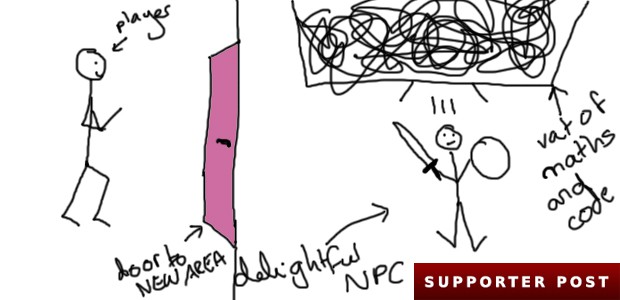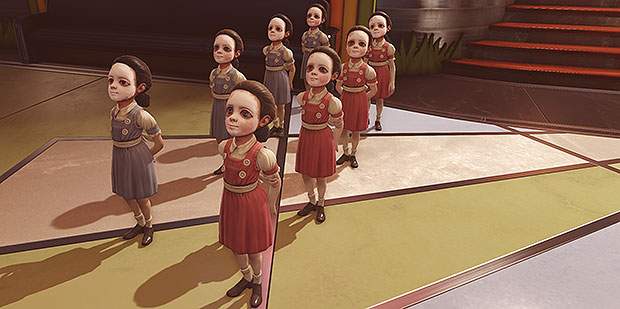
The future aka 4K gaming is made up of very, very small pixels. After spending the past two weeks checking out games on Samsung's U28D590D 4K monitor, I'm still going to call 4K gaming the near future rather than the present. Yes, you can play games at 3840x2160 pixels right now. Yes, 4K monitors are becoming more affordable. But are they worth it? After spending a couple weeks using one, I can comfortably say: no, not yet. Even for a high-end graphics card (or two), 4K is too demanding for max settings and high framerates. If you're willing to play at 30 frames per second, though, 4K is a different story.
If you want to skip straight to the 4K gameplay section, click here to jump to page 2.
The Samsung U28D590D and the basics of 4K
The Samsung U28D590D is a 28-inch, 3840x2160 monitor that has an MSRP of $700, though it's only $570 on Amazon as of this writing. The monitor has a 60Hz refresh rate, unlike some earlier 4K monitors, though you'll have to use DisplayPort for 60Hz. The current HDMI spec only supports 4K at 30Hz.
I gave a general overview of the U28D590D and the demands of 4K gaming in a segment of The PC Gamer Show, which you can watch here:
The monitor looks great and I never noticed any issues with refresh rate or response time, but I didn't perform in-depth testing to determine the actual response time (never trust the too-good-to-be-true listed response time. TFT Central offers a good primer on what those specs mean). Because it uses a faster, cheaper TN panel, response time comes at a cost: inferior viewing angles and color accuracy compared to IPS displays. The monitor stand is also disappointingly limited--it has no height adjustment, rotation, or VESA mount support.
Unfortunately, if you're still running Windows 7, 4K is a terrible experience, no matter what 4K monitor you're using. The OS isn't designed to scale to such a high resolution, and everything will be impossibly tiny unless you crank up DPI scaling to 125% or 150%. But that scaling is for text it doesn't properly resize other UI elements or affect some applications like Steam. Chrome doesn't scale its text properly, either. Windows 8 is much better about properly scaling, and requires no setup to scale text, UI elements like Windows Explorer, and applications to 4K resolution. Text in Steam and Chrome is noticeably fuzzier than system text, but everything is usable and legible without constantly squishing your face up against the monitor.
The Samsung's $570 may be cheap for a 4K monitor, but it's still expensive for a monitor, in general. What that money buys is an extremely pixel-dense display, and games really do look amazing on it. My standard monitor is a 27-inch, 2560x1440 display, which comes out to a pixel pitch rating of 108.79 PPI. That's way higher than, say, a 24-inch 1080p monitor (95.78 PPI) or a 50-inch 1080p TV (44.06 PPI).
At 3840x2160, the 28-inch Samsung U28D590D has a 157.35 PPI. As a result, games running at native resolution look sharp, even without anti-aliasing enabled. The pixel density really does make a difference. Remember, a 1920x1080 monitor creates an image out of 2,073,600 pixels. A 4K monitor displays 8,294,400 pixels. As a result, a graphics card has to push out four times as many pixels. Not even two Nvidia Titans, or a newer Titan Black, can handle refreshing eight million pixels 60 times per second.
On the next page: my gaming experiences with Metro: Last Light, Tomb Raider, and other games, with some gameplay footage captured with Nvidia Shadowplay (at the max capture resolution of 1440p).
Gaming at 4K
The first game I tested at 4K was the most graphically intensive game I could think of: Metro: Last Light. With settings cranked up to Ultra, Last Light had trouble cracking 20 frames per second. Mostly, it ran in the teens, and even lowering a few settings barely helped. The world isn't ready for Metro: Last Light at 4K. Luckily, most of the other games I tested ran better.
For the games listed below, I'm going to give a rating based on playability at 30 fps and 60 fps. While I did tweak some specific settings like antialiasing, depth of field, and tessellation, I didn't turn game settings down to medium or low just to see if they'd perform well. I'd rather play a game at high settings, with better textures, lighting, and particle effects, than sacrifice those graphics options for pure resolution.
Bioshock Infinite
Bioshock Infinite runs on a heavily customized Unreal Engine 3, but it's not a particularly demanding game I had no problem running it at 60 fps on an AMD 7870 at 1440p when it was released. At 4K on a Titan Black, with all settings on Ultra, it was playable, but the framerate fluctuated considerably. It only occasionally reached 60 frames per second, and mostly hovered in the low 40s. Not bad! Usually. I found that some particle effects and rapid animations like the carnival games in the plaza near the beginning of the game--sent the framerate plummeting down into the teens.
By switching Bioshock Infinite's settings down to "Very High," I was able to run it at a reliable 30+ fps. I also ran the Infinite benchmark utility on its highest setting: DX11 with Depth of Field enabled. It averaged an overall framerate of 37.01 fps.
Consistent 60 fps at 4K? No.
Consistent 30 fps at 4K? Yes.
Tomb Raider
When I played Tomb Raider on my (overclocked) AMD 7870 last year, I was shocked by how well-optimized it was. I ran the game at max settings, with TressFX enabled, and kept a solid 60 fps. It didn't fare as well at 4K. At first, I ran the game at Ultra on a Titan Black, with only TressFX disabled. Depth of Field was turned to high, and tessellation was enabled. On those settings, the game typically ran at 22-24 fps and peaked around 30 fps. That framerate, combined with the game's handheld-style shaky camera, made cutscenes uncomfortably twitchy to watch. In smaller enclosed spaces, the game ran better when I took Lara into an underground area, it actually ran at 55-60 fps.
Tweaking individual settings in Tomb Raider also makes a big difference. By disabling tessellation and turning down depth of field and SSAO to normal, the framerate hung steady in the mid-30 fps range, even in cutscenes and open environments. I didn't get to any of the game's dramatic action setpieces, but a little settings tuning should be enough to keep the game running over 30 fps at all times.
Consistent 60 fps at 4K? No.
Consistent 30 fps at 4K? Yes.
Sleeping Dogs
United Front Games' Sleeping Dogs has a gorgeous open world, but it relies on the rain-soaked neon of Hong Kong for its looks, not tessellation like Tomb Raider or the lighting and physics of Metro: Last Light. With all of Sleeping Dogs' settings cranked to Ultra (except anti-aliasing) and its high resolution textures installed, the game managed to run at an almost-but-not-quite solid 60 fps during gameplay. It sometimes dipped into the 50s, but still played extremely smoothly.
During cutscenes, the framerate dropped into the 40-50 fps range, but never dipped anywhere near 30 fps.When I ran the Sleeping Dogs benchmark utility (with AA enabled), it returned an average framerate of 56.5 fps, a maximum of 67.1 fps and a minimum of 39.2 fps. Not bad, Sleeping Dogs. Not bad. And you still look pretty good, too.
Consistent 60 fps at 4K? Very, very close.
Consistent 30 fps at 4K? Yes. Easily.
Counter-Strike: Global Offensive
Surprise! A game running on the Source Engine runs putters along at 4K resolution and 60 frames per second just fine. On the Large Pixel Collider's three Titan setup, CS:GO blazed past 60 fps with max settings and showed no signs of dipping down below that threshold. Even on a weaker computer, Source engine games should be able to run at 60 fps no problem, especially with tweaking to settings like AA.
Consistent 60 fps at 4K? Yes.
Consistent 30 fps at 4K? Double yes.
Total War: Rome 2
The last game I tried, Creative Assembly's Total War: Rome 2, ran better than I expected. The Total War games are notoriously system intensive on both the CPU and GPU, but even on Ultra settings, the game ran well at 4K. At least, "well" by Total War standards. On the battlefield, zoomed out, the game consistently ran at more than 30 fps. Zoomed in, the framerate slowed to around 24 fps when there were dozens or hundreds of units on screen at once. But that feels normal for Total War, so the game didn't feel sluggish.
In fact, on a Titan Black, Total War: Rome 2 runs better at 4K than it did for me at launch on my AMD 7870 at 1440p. Creative Assembly has patched the game numerous times over the past year to fix bugs and increase performance, but overall Rome 2 ran better than I expected. Still nowhere near 60 fps, but that's hardly a surprise for a game rendering thousands of units at once.
Consistent 60 fps at 4K? No, but that's no surprise.
Consistent 30 fps at 4K? No, but closer than expected.
Wrapping up
The games above are just a small sample of how PC gaming fares at 4K resolution. Obviously performance will differ between systems not everyone has a Titan Black to play on, but a pair of overclocked SLI'd cards could handle these games even better, and even manage to keep framerates hovering around 60 fps. From my testing, though, I don't think 2014 is the year to invest in a 4K monitor. Even 30 fps at 4K is a struggle for some games, but it's doable with the right tweaking.
If you're accustomed to playing games at 30 frames per second already, chances are you don't have a graphics card capable of handling 4K. Buy a new GPU in 2014 or 2015, though, and 4K at 30 fps will be within your reach
For 60 fps, you'll need at least two Nvidia 780 TIs in SLI or an AMD R9 295X2, and neither of those cards will guarantee 60 fps in every game. Total cost for those cards? Between $1400 and $1500. Throw the cost of the 4K monitor in there, and, well...Unless you want to spend a whole lot of money, the 4K future is still a year or two away.
















